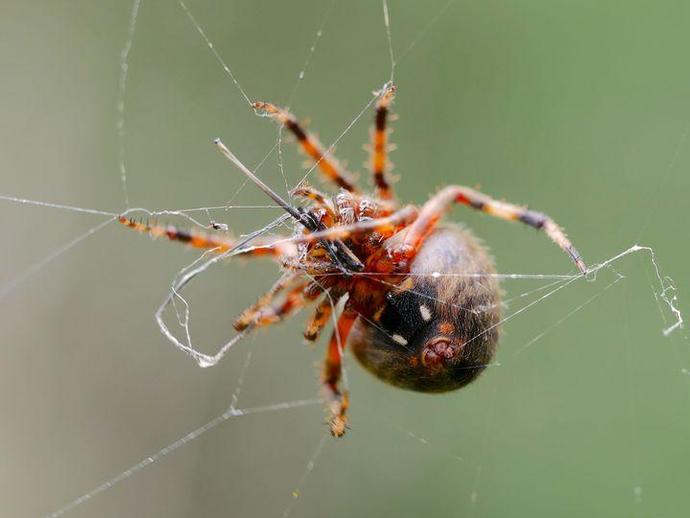January 21, 2022
We're reaching into the archives for today's #BenInNature update presented by our friends at Carter Bank & Trust! The following post was originally published on October 30, 2020.
This is a Hentz orbweaver (Neoscona crucifera), and it looks extremely similar to the related spotted orbweaver (Neoscona domiciliorum). These sizable orbweaver spiders can be found across most of the U.S. and down into Mexico, and they're active from June through November.
Now that fall has arrived, there's a good chance that you've seen either this spider or the spotted orbweaver outside your home. At dusk, these spiders build large wheel-shaped webs and wait in the middle for prey to fly by. When a prey insect smacks into the web, the spider moves into action, biting the insect to immobilize it and then wrapping it in silk. She may eat the meal right then or save it for later. As you can see in the photo, that's the fate that befell whatever's left of the bug that this particular spider is eating (I think it used to be a crane fly).
Once dawn arrives, orbweavers take their webs down and eat them. They're able to recycle the proteins in the silk and use them to spin the next night's web!
While these spiders may look pretty terrifying if you're an arachnophobe -- especially in a clear macro shot that highlights every single tiny hair (sorry about that) -- these spiders are quite docile. If threatened, their first instinct is to drop to the ground and run away. They rarely bite humans, and even then, they only bite if they've been very roughly handled. If you have these spiders on your property, the best thing to do is leave them be; they'll eat a lot of pest insects for you and their webs are quite beautiful!
ABOUT #BenInNature
Social distancing can be difficult, but it presents a great opportunity to become reacquainted with nature. In this series of posts, Administrator of Science Ben Williams ventures outdoors to record a snapshot of the unique sights that can be found in the natural world. New updates are posted Monday - Friday, with previous posts highlighted on the weekends. This series of posts is made possible thanks to the support of VMNH Corporate Partner Carter Bank & Trust (www.cbtcares.com).
NATURE PHOTO IDENTIFICATIONS
If you discover something in nature that you would like help identifying, be sure to message us right here on Facebook with a picture (please include location and date of picture) and we'll have our experts help you identify it!

 Hours & Admissions
Hours & Admissions Directions
Directions

